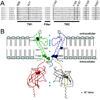The role of an inwardly rectifying K(+) channel (Kir4.1) in the inner ear and hearing loss
- PMID: 24480364
- PMCID: PMC4007161
- DOI: 10.1016/j.neuroscience.2014.01.036
The role of an inwardly rectifying K(+) channel (Kir4.1) in the inner ear and hearing loss
Abstract
The KCNJ10 gene which encodes an inwardly rectifying K(+) channel Kir4.1 subunit plays an essential role in the inner ear and hearing. Mutations or deficiency of KCNJ10 can cause hearing loss with EAST or SeSAME syndromes. This review mainly focuses on the expression and function of Kir4.1 potassium channels in the inner ear and hearing. We first introduce general information about inwardly rectifying potassium (Kir) channels. Then, we review the expression and function of Kir4.1 channels in the inner ear, especially in endocochlear potential (EP) generation. Finally, we review KCNJ10 mutation-induced hearing loss and functional impairments. Kir4.1 is strongly expressed on the apical membrane of intermediate cells in the stria vascularis and in the satellite cells of cochlear ganglia. Functionally, Kir4.1 has critical roles in cochlear development and hearing through two distinct aspects of extracellular K(+) homeostasis: First, it participates in the generation and maintenance of EP and high K(+) concentration in the endolymph inside the scala media. Second, Kir4.1 is the major K(+) channel in satellite glial cells surrounding spiral ganglion neurons to sink K(+) ions expelled by the ganglion neurons during excitation. Kir4.1 deficiency leads to hearing loss with the absence of EP and spiral ganglion neuron degeneration. Deafness mutants show loss-of-function and reduced channel membrane-targeting and currents, which can be rescued upon by co-expression with wild-type Kir4.1. This review provides insights for further understanding Kir potassium channel function in the inner ear and the pathogenesis of deafness due to KCNJ10 deficiency, and also provides insights for developing therapeutic strategies targeting this deafness.
Keywords: EAST; KCNJ10; SeSAME; deafness; endocochlear potential; spiral ganglion.
Published by Elsevier Ltd.
Figures



Similar articles
-
Time course of inner ear degeneration and deafness in mice lacking the Kir4.1 potassium channel subunit.Hear Res. 2003 Mar;177(1-2):71-80. doi: 10.1016/s0378-5955(02)00799-2. Hear Res. 2003. PMID: 12618319
-
[EAST/SeSAME syndrome and functional expression of inward rectifier potassium channel Kir4.1 in the inner ear].Lin Chuang Er Bi Yan Hou Tou Jing Wai Ke Za Zhi. 2015 Jul;29(14):1318-22. Lin Chuang Er Bi Yan Hou Tou Jing Wai Ke Za Zhi. 2015. PMID: 26672256 Review. Chinese.
-
Expression of an inwardly rectifying K+ channel, Kir5.1, in specific types of fibrocytes in the cochlear lateral wall suggests its functional importance in the establishment of endocochlear potential.Eur J Neurosci. 2004 Jan;19(1):76-84. doi: 10.1111/j.1460-9568.2004.03092.x. Eur J Neurosci. 2004. PMID: 14750965
-
An ATP-dependent inwardly rectifying potassium channel, KAB-2 (Kir4. 1), in cochlear stria vascularis of inner ear: its specific subcellular localization and correlation with the formation of endocochlear potential.J Neurosci. 1997 Jun 15;17(12):4711-21. doi: 10.1523/JNEUROSCI.17-12-04711.1997. J Neurosci. 1997. PMID: 9169531 Free PMC article.
-
Inwardly rectifying potassium channels (Kir) in central nervous system glia: a special role for Kir4.1 in glial functions.J Cell Mol Med. 2006 Jan-Mar;10(1):33-44. doi: 10.1111/j.1582-4934.2006.tb00289.x. J Cell Mol Med. 2006. PMID: 16563220 Free PMC article. Review.
Cited by
-
KIT gene mutation causes deafness and hypopigmentation in Bama miniature pigs.Am J Transl Res. 2020 Sep 15;12(9):5095-5107. eCollection 2020. Am J Transl Res. 2020. PMID: 33042408 Free PMC article.
-
Emerging Mechanisms in the Pathogenesis of Menière's Disease: Evidence for the Involvement of Ion Homeostatic or Blood-Labyrinthine Barrier Dysfunction in Human Temporal Bones.Otol Neurotol. 2023 Dec 1;44(10):1057-1065. doi: 10.1097/MAO.0000000000004016. Epub 2023 Sep 20. Otol Neurotol. 2023. PMID: 37733989 Free PMC article.
-
Connexins 30 and 43 expression changes in relation to age-related hearing loss.Hear Res. 2024 Mar 15;444:108971. doi: 10.1016/j.heares.2024.108971. Epub 2024 Feb 11. Hear Res. 2024. PMID: 38359484 Free PMC article.
-
Expanding the genotypic and phenotypic spectrum of EAST/SeSAME syndrome: identification of a novel homozygous mutation (c.194 G > A) in KCNJ10 gene.Neurol Sci. 2025 Feb;46(2):911-927. doi: 10.1007/s10072-024-07834-9. Epub 2024 Nov 28. Neurol Sci. 2025. PMID: 39607615
-
ATP-sensitive K(+) channels (Kir6.1/SUR1) regulate gap junctional coupling in cochlear-supporting cells.Pflugers Arch. 2016 Jul;468(7):1215-1222. doi: 10.1007/s00424-016-1815-8. Epub 2016 Mar 31. Pflugers Arch. 2016. PMID: 27030354
References
-
- Ando M, Takeuchi S. Immunological identification of an inward rectifier K+ channel (Kir4.1) in the intermediate cell (melanocyte) of the cochlear stria vascularis of gerbils and rats. Cell Tissue Res. 1999;298:179–183. - PubMed
-
- Blatchley BJ, Cooper WA, Coleman JR. Development of auditory brainstem response to tone pip stimuli in the rat. Dev Brain Res. 1987;32:75–84. - PubMed
-
- Bockenhauer D, Feather S, Stanescu HC, Bandulik S, Zdebik AA, Reichold M, Tobin J, Lieberer E, Sterner C, Landoure G, Arora R, Sirimanna T, Thompson D, Cross JH, van't Hoff W, Al Masri O, Tullus K, Yeung S, Anikster Y, Klootwijk E, Hubank M, Dillon MJ, Heitzmann D, Arcos-Burgos M, Knepper MA, Dobbie A, Gahl WA, Warth R, Sheridan EK, et al. Epilepsy, Ataxia, Sensorineural Deafness, Tubulopathy, and KCNJ10 Mutations. N Engl J Med. 2009;360:1960–1970. - PMC - PubMed
-
- Bond CT, Pessia M, Xia XM, Lagrutta A, Kavanaugh MP, Adelman JP. Cloning and expression of a family of inward rectifier potassium channels. Receptors Channels. 1994;2:183–191. - PubMed
Publication types
MeSH terms
Substances
Grants and funding
LinkOut - more resources
Full Text Sources
Other Literature Sources

